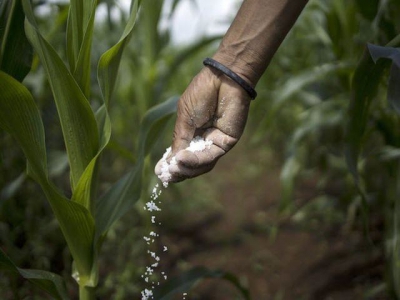Rising fertilizer costs requires farmers to spread with caution

As the weather has turned colder, harvest is hopefully coming close to conclusion and winter chores are taking less time, it is time to focus on planning for next year.
Indian farmers squeezed by a massive shortage of fertilizers are turning to the black market and paying exorbitant prices for supplies. Photo: Business Standard
Whether in a cropping or livestock enterprise, the basis to success begins with a good fertility program. With fertilizer prices approaching levels not seen in nearly a decade, that fertility program will come with a hefty price tag in 2022, and let’s face it, there weren’t any Black Friday deals on DAP or Potash last week.
Let’s look at some options that will help you be successful in 2022.
With rising fertilizer costs and uncertainty in prices and even supply for many fertilizer products going into the spring, many producers are asking where they can trim down their fertilizer application for next year. While skimping on fertility never is recommended, there are some areas in which farmers can be a little more conservative.
First of all, be sure to soil test. You have no way of knowing what a crop needs without an accurate soil test and without one, you could be over applying some nutrients, ultimately throwing away money.
Once you get those soil test results back, sit down and take a close look at them. These results reflect how many pounds of nutrient need to be applied in order to build and maintain high soil test levels of the nutrient. Improved crop response is only seen when levels are in the low to low-medium range.
Most agents review UK Soil Test results and make note of test levels that are in the low and low-medium ranges. If you receive results through Hardin County, we are on UK’s new soil testing program and your levels will be color coded: Green means you’re good to go, Yellow means Caution and Red means you are in the danger zone. These noted recommendations cannot be reduced without excepting decreased plant performance.
If soil test levels are in the high-medium to high ranges, nutrient applications can be reduced with little to no effect on plant performance in the coming year. Be extremely cautious if you do choose to be conservative on application of nutrients in these levels though. If you don’t put it on this year, you will probably have to apply this and more next year. You can only mine fertility for so long before it catches up to you, and crop performance is affected.
Once you decide how much fertilizer to apply, it’s time to decide when you are going to apply it. If it is in a corn or grass crop, then the simplest time to apply phosphorus and potassium is in the spring when the nitrogen application is made. This saves a trip across the field, saving both fuel and time. If applying ahead of soybeans or to a legume forage, your application window can be a little wider.
It may be a good idea to go ahead and apply P and K this fall/winter in these situations this year for a couple of reasons.
Although the price is high, prices are likely lower now than they will be come spring. Also, most dealers are currently not allowing you to lock in a spring fertilizer price with prepay. Applying and paying for fertilizer now locks that price in.
We know the supply of fertilizer is there now and applicators are likely to not be as busy now as they will be in spring. If you are applying yourself, you likely have more time now than you will in the busy spring season. If you plan to apply fertilizer in the winter, be sure that the ground is either firm or frozen to be sure the application equipment is not creating compaction or making ruts in the field.
One final note regarding pasture fertility. It will be extremely hard to pencil fertilizer applications on pasture this year, especially if fertility levels are in the medium to high range. Remember, in a pasture, the animal recycles roughly two-thirds of the nutrients it consumes from the forage back through it’s manure. Planning out grazing systems pays dividends in evenly distributing these recycled nutrients back throughout the pasture.
Also, planning out your hay feeding this winter can further help with pasture fertility. Make sure not to feed hay near loafing areas and/or water sources. This forces the animal to move around the pasture, more evenly distributing manure across the field. Unrolling hay or bale grazing are also good ways to help distribute nutrients across a pasture in the winter.
Also, take note of clover stands in pastures, and if stands are thin, consider frost seeding some clover in February to minimize the need for supplemental nitrogen fertilizer in the spring.
Take some time and plan out your fertility program for 2022. Let’s prepare and hope for a bumper crop next year, so that we can continue on with the task of feeding a hungry world.
Có thể bạn quan tâm
 Ho Chi Minh City promotes local agricultural produce at affordable prices
Ho Chi Minh City promotes local agricultural produce at affordable prices Many traders in HCM City have been promoting local agricultural products at affordable prices to maintain market share.
 Digital transformation to boost agriculture development
Digital transformation to boost agriculture development Digital transformation is to provide the answers to a number of key limitations and shortcomings in Việt Nam's agriculture sector, said experts and policymakers
 Developing organic farming in Cao Bang Province’s Phja Den Mountain
Developing organic farming in Cao Bang Province’s Phja Den Mountain Kolia Co., Ltd., has researched and grown organically many agricultural crops, including tea, on the top of Phja Den Mountain in Thanh Cong Commune